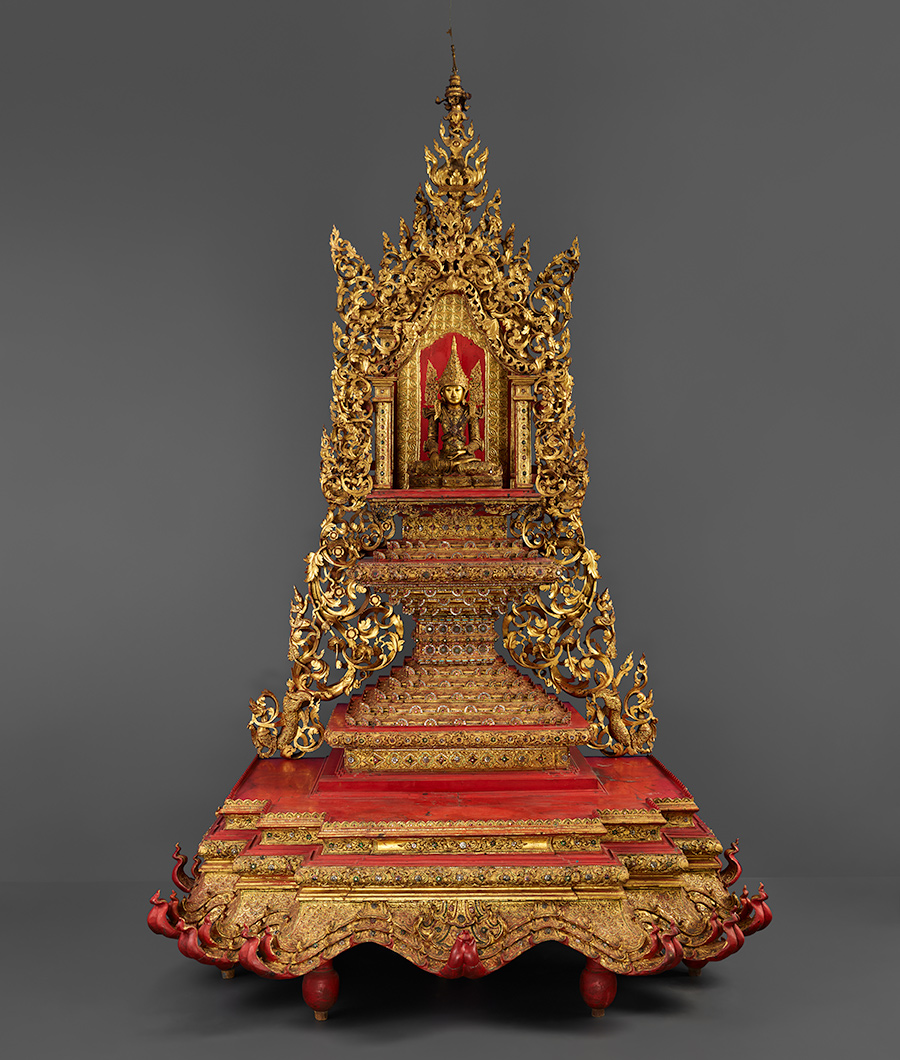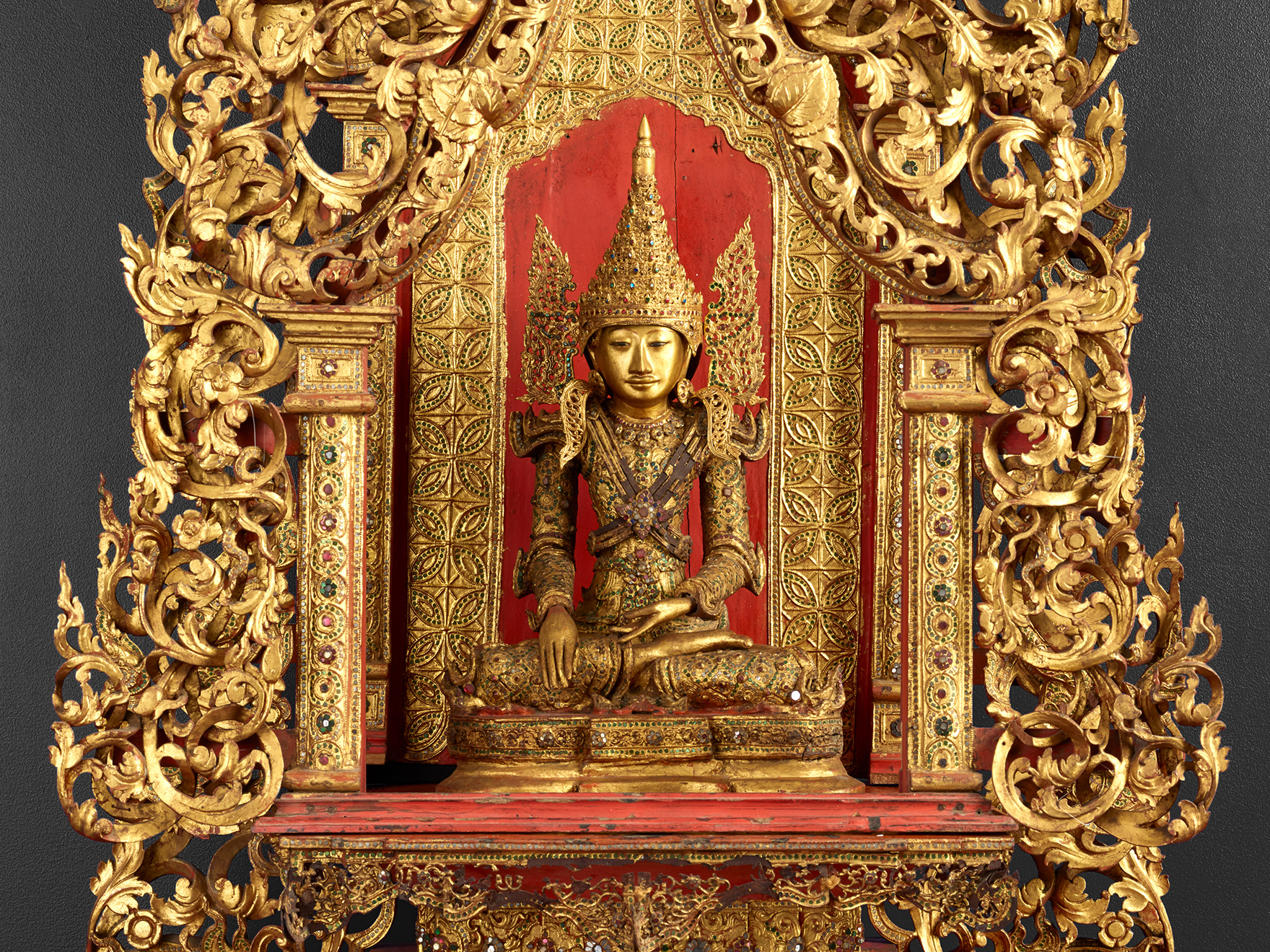This lavish enthroned Buddha evokes the elaborate temple interiors of 19th-century Burma.

Crowned and bejeweled Buddha image and throne
Approx. 1860–1880
Myanmar (Burma); Mandalay area
Wood and iron, with lacquer, gilding, and mirrored glass
Gift from Doris Duke Charitable Foundation’s Southeast Asian Art Collection, 2006.27.17 and 2006.27.1.a-.t
This elaborate lacquered and gilded throne houses a crowned image of the Buddha. A throne such as this one would have been an important feature of 19th-century temples in Burma, now known as Myanmar, where Buddhists would venerate the image as a reminder of the Buddha’s sacred essence and his teachings. Although the young prince who became the Buddha renounced his royal status, the throne, crown, and other kingly adornments convey the supremacy of his message.

Although the Buddha is more often shown in plain robes, this highly ornamented representation is also recognizable as the Buddha because of the characteristic position and hand gesture. Many images of the Buddha show him seated with legs folded and with his right hand reaching down to call on the earth as a witness in his struggle with the demon Mara, who represents craving, illusion, and death.
Such an elaborate throne and Buddha image would have been an important fixture of a 19th-century Buddhist temple in Burma (now Myanmar), and similar ones can still be seen in temples there today. The significance of the crowned and bejeweled Buddha image varied in different places and periods. In Thailand and Myanmar, the story of Jambupati offers an explanation: At the beginning of his spiritual quest, the young prince who became the Buddha discarded his royal garments and put on a robe made of rags. After the prince attained buddhahood, an arrogant king named Jambupati attempted to display his superiority to all the other kings of the world. In response, the Buddha manifested himself enthroned in a magically created palace, adorned with royal finery, to teach Jambupati that the grandeur of the Buddha and his message vastly outshines that of earthly kingship. The Buddha then preached to Jambupati of the emptiness of riches, the inevitability of suffering, and the impermanence of all things.
Like royal thrones of Myanmar (Burma), this throne shrine has multiple tiers that step inward then outward again (see image gallery above). The lower tiers refer to mountain ranges that in Buddhist cosmology make up the world, with Mount Meru as the central axis. The upper tiers refer to the higher heavens.
At the top of this throne shrine is a miniature parasol, an ancient royal symbol (see image gallery above). In India and Southeast Asia, parasols were (and sometimes still are) held over kings and other revered persons to protect them from the sun and elements. Eventually the parasol became a symbol of high rank.
In the museum, the throne shrine is displayed with other art objects arranged around it to evoke, in a general way, the feeling of being in a Buddhist temple in Myanmar (Burma) or Thailand (see image gallery above). In temples, the main Buddha image is often densely surrounded by all sorts of other objects from various regions and time periods, such as sculptures, offering containers, and donations from pious people. Many Buddhists believe that a consecrated image is in some sense a living embodiment of the Buddha’s teachings and should be venerated and treated with the highest possible respect. They leave offerings such as flowers, fruit, candles, incense, and sometimes even impressive items like grandfather clocks.
The lavishly decorated box on this throne shrine was made to contain a handwritten copy of a sacred Buddhist text (see image gallery above). Many Buddhists say that they “take refuge” in the “Three Jewels”: the Buddha, the teachings (the dharma) passed down both orally and in writing, and the religious community (the monkhood, or sangha). This display incorporates all three: a modern printing of a Buddhist text (representing the dharma) is placed inside the box on the throne shrine and a sculpture of the monk Shariputra represents the sangha (see image gallery above).
The throne shrine is made up of 20 components of lacquered and gilded wood that fit together like pieces of a 3D puzzle. The museum’s installation crew needs several hours to assemble or disassemble the shrine (see video above).
Expert artisans carved teakwood into a variety of intricate designs, then they coated it with red lacquer and gold leaf and encrusted it with jewel-like pieces of mirrored glass, creating a resplendent effect that recalls the art of the goldsmith. In the often hot, damp climate of Myanmar (Burma), wood is vulnerable to damage from moisture and termites. Coating it with lacquer helps protect the wood.
The style, materials, and fabrication of the throne shrine tell us that it was probably made in Myanmar (Burma) when the capital was at Mandalay (1857–1885). The arts of Mandalay are characterized by rich colors, intricate decoration, and frequent use of gilding that create an opulent impression.
The Burmese kingdom began the 19th century strong and vigorous. Little by little, though, it lost territory to the British. When Mandalay was founded as the new capital in 1857, all of the rich coastal areas of Burma were in British hands, and Mandalay could conduct trade only through the British. Even so, the Mandalay period saw a flourishing of architecture and other arts as well as music and theater. The new capital of Mandalay retained power only until 1885, when British forces occupied the city and sent the king into exile.
This throne shrine and image were purchased in the 1960s by the wealthy art collector (and celebrity) Doris Duke (1912–1993), who assembled a huge group of Southeast Asian artworks with the intention of displaying them for the benefit of the public in a Southeast Asian cultural park in Honolulu. Her plans were never realized in the way she hoped, and eventually this throne and the rest of the collection ended up at Duke’s estate in New Jersey, where visitors could sometimes see them. Some years after her death, many of the art objects were given to the Asian Art Museum and the Walters Art Museum in Baltimore, and smaller numbers of objects to other museums around the country. There are no records of exactly where the throne shrine originally came from or how Duke’s agent bought it.
The original crown of this Buddha image disappeared long ago. The one the image now wears was made using traditional techniques and in the traditional style in 2002 by U Win Maung, an expert artisan in Mandalay, Myanmar. It was commissioned and then donated to the museum in memory of M. R. Vadhanathorn Chirapravati. The rest of the Buddha image’s royal decorations appear to be original.
Zoom in and dive deeper:
Explore the symbolism of the Buddha's ornate throne on Google Arts & Culture